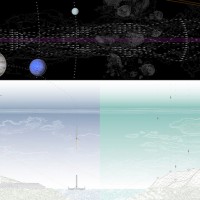Kosmorama, Nova Cinema, movie theatre # 9, March 12, 2016.
Spaceship Mind – Virtual Migration to Exoplanets
Krists Ernstsons (LV)
http://pr2015.aaschool.ac.uk/DIP-18/Krists-Ernstsons
It is an astonishing revelation that the most complex structure in the known universe, in the current space and time, is the human brain. Buckminster Fuller wrote the ‘Operating Manual for Spaceship Earth’ and to this date it is very relevant in the context of Earth, but as the father of Russian Astronautics (Konstantin E. Tsiolkovsky) said: “The earth is a cradle of the mind, but we cannot live forever on a cradle.” What if the spaceship that we live on is not the Earth, but the mind?
Earth is inevitably faced with climate change and eventually our impact will make its mark so deep that we will need to look for a new place to live in space if we wish preserve the human species, or in fact any species.
What makes Earth habitable is liquid water – if there is no blue there is no green. Water creates atmosphere – the second skin that makes our existence possible. Only recently we have discovered that there are Earth like planets in other solar systems, orbiting another star in the Goldilocks zone. They are called Exoplanets. If there are other intelligent life forms out there, then most likely we are to find them on Exoplanets. There is just one small problem – the speed of light.
Krists Ernstsons
Krists Ernstsons completed his Part I in Architecture at the University of East London and his Part II Diploma in Architecture at the AA (Architectural Association School of Architecture). His thesis project ‘Virtual Migration to Exoplanets’ was nominated for honours and explored the idea of breaking the speed of light boundary through quantum entanglement and migrating to Earth like planets at the macro scale. The key drive for this study was the idea that humanity eventually will grow out of its cradle called the planet Earth.
After his Part I he worked for Foster + Partners in London where he prototyped a household unit to revolutionise efficiency and functionality of low-income housing. In 2010 he joined Izolyatsia – Platform for Cultural Initiatives in Ukraine, where he worked on masterplanning, refurbishment, curating a residency programme and executing projects by internationally renowned artists. Currently Krists works at Hawkins\Brown in the infrastructure sector.
Krists has a very ‘hands on’ approach towards Architecture and Architectural thinking. He is particularly interested in systems, ecological efficiency, biochemistry and physics as the new ways through which Architecture can become more than just buildings. He believes that the contemporary human must be a global citizen.
In his spare time Krists enjoys cycling, analysing the future and science, making and spending time in the garage with his friends.









